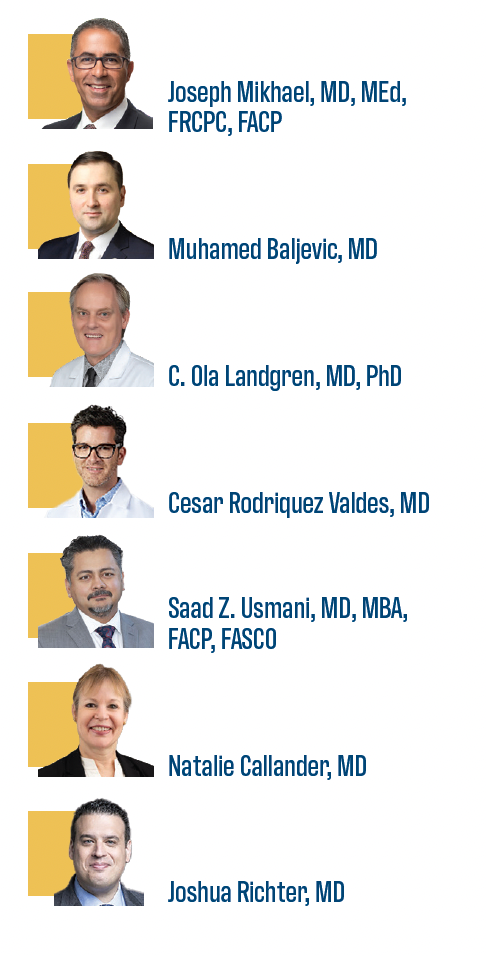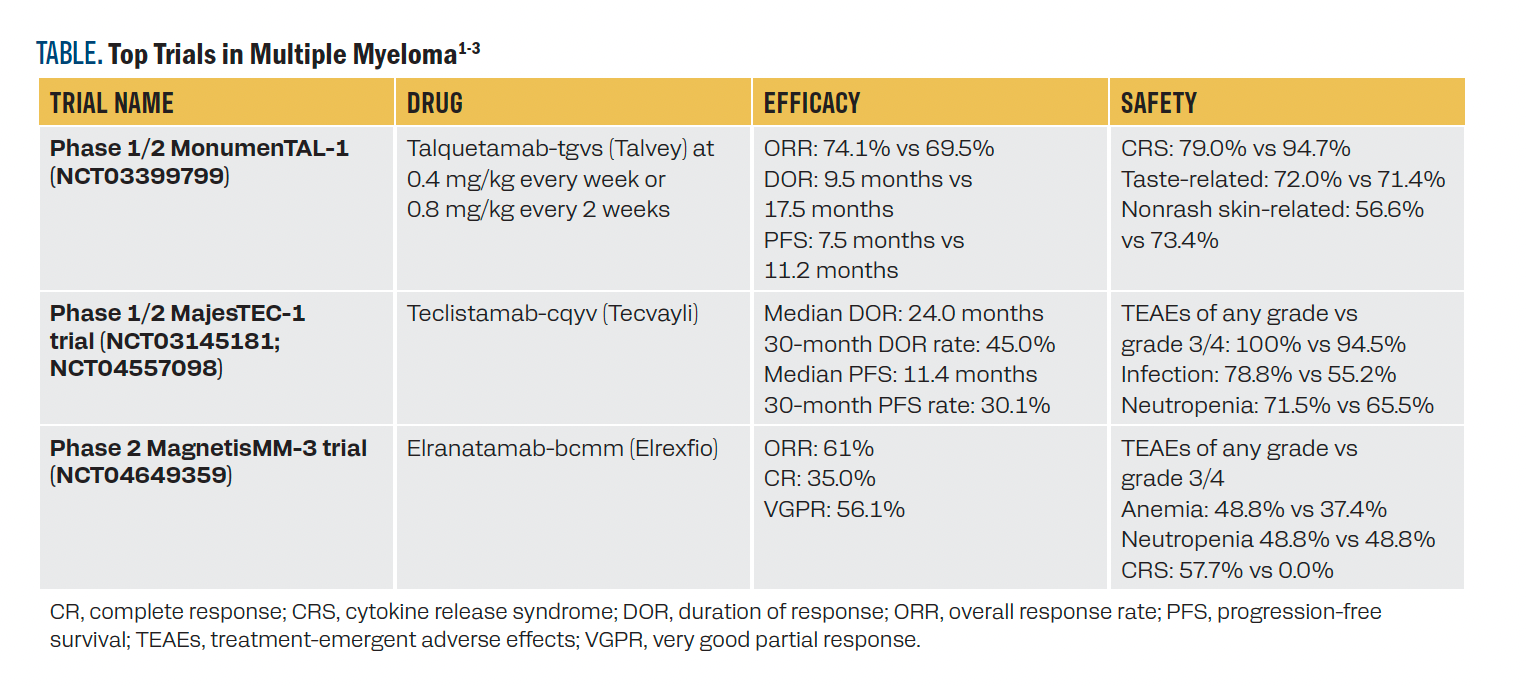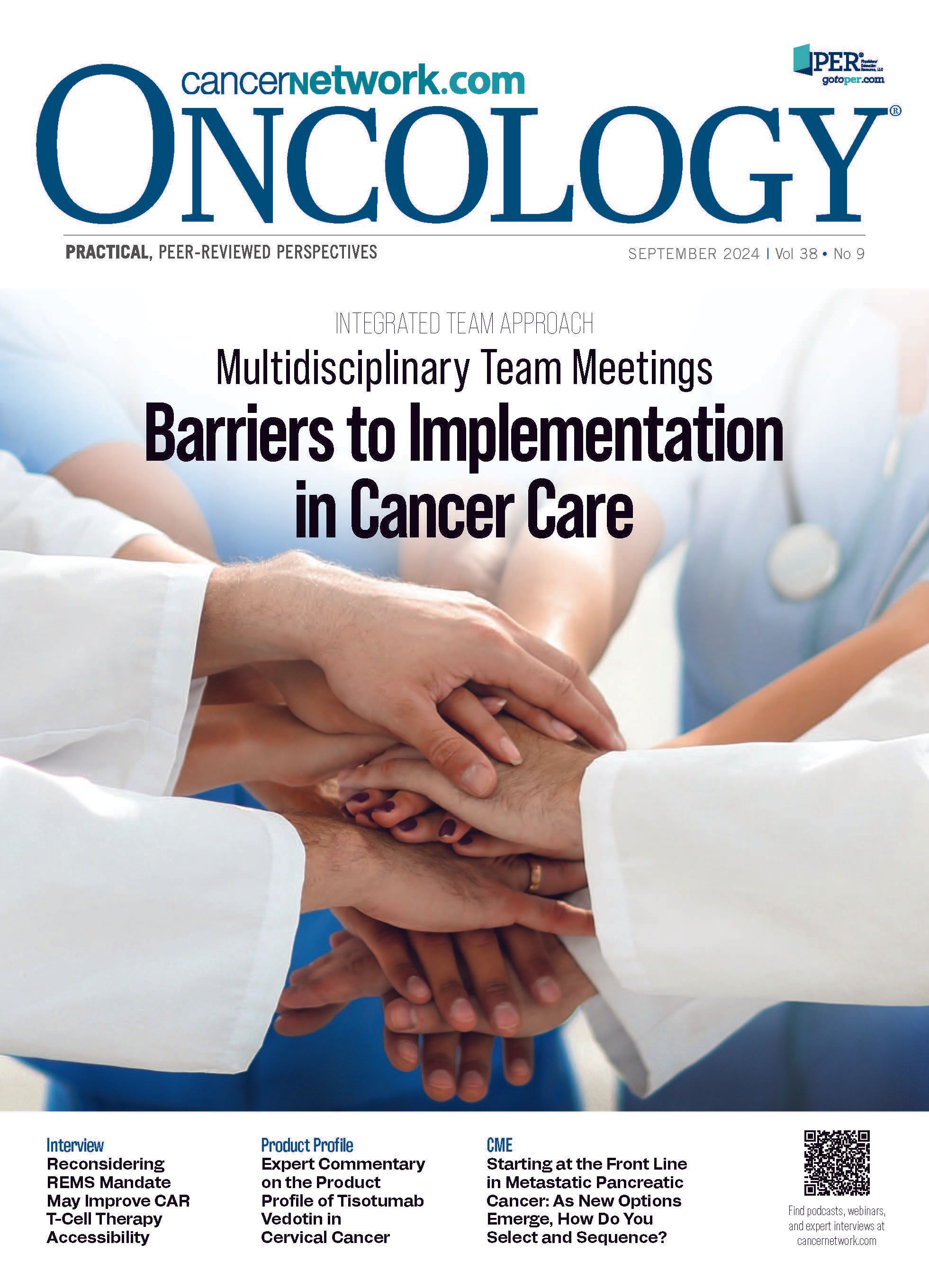Determining Administration of BCMA, T-Cell Engagers in R/R Multiple Myeloma
Experts in multiple myeloma discussed optimal dosing strategies for bispecific antibodies for patients with relapsed/refractory multiple myeloma.
The expert panel

The assessment of updated clinical trial data, optimal dosing strategies, and integration of bispecific antibodies into current relapsed/refractory multiple myeloma treatment paradigms were the focus of conversation during a Frontline Forum event. Experts in multiple myeloma gathered to discuss these points of interest and experiences they have had in the clinic.
The panel was led by Joseph Mikhael, MD, MEd, FRCPC, FACP, professor in the Division of Applied Cancer Research and Drug Discovery at the Translational Genomics Research Institute, an affiliate of City of Hope, in Phoenix, Arizona. He is also the chief medical officer of the International Myeloma Foundation.
He was joined by Muhamed Baljevic, MD, associate professor of medicine in the Division of Hematology-Oncology, director of the Plasma Cell Disorders Research of Vanderbilt-Ingram Cancer Center (VICC), director of the Vanderbilt Amyloidosis Multidisciplinary Program, and cochair of the VICC Protocol Review and Monitoring Program in Nashville, Tennessee; C. Ola Landgren, MD, PhD, professor of medicine, chief of the Division of Myeloma, director of the Sylvester Myeloma Institute, coleader of the Translational and Clinical Oncology Program, and Paul J. DiMare Endowed Chair in Immunotherapy at the University of Miami Miller School of Medicine in Florida; Cesar Rodriguez Valdes, MD, associate professor of medicine at the Icahn School of Medicine at Mount Sinai, and clinical director of Multiple Myeloma at Mount Sinai Hospital in New York, New York; Saad Z. Usmani, MD, MBA, FACP, FASCO, chief of the Myeloma Service at Memorial Sloan Kettering (MSK) Cancer Center in New York, New York; Natalie Callander, MD, professor in the Division of Hematology, Medical Oncology, and Palliative Care at the University of Wisconsin School of Medicine and Public Health in Madison; and Joshua Richter, MD, associate professor of medicine in the Tisch Cancer Institute at the Icahn School of Medicine at Mount Sinai, director of Multiple Myeloma at the Blavatnik Family-Chelsea Medical Center at Mount Sinai and editorial advisory board member for ONCOLOGY.
Discovering the Ideal Talquetamab Dose
TABLE. Top Trials in Multiple Myeloma

The panelists started by going through the data of important trials in multiple myeloma (Table1-3). Regarding the MonumenTAL-1 trial, Richter commented that although there was a high response rate, duration of response and progression-free survival were significantly less. He noted that additional work is needed on this trial because although the response was high, it was not durable.
“It’s showing that every other week [dosing] is much more beneficial overall. I don’t think it’s changing our practice. All of us are already using [talquetamab] every other week, where it just reaffirms the fact that we’re on the right path,” Rodriguez said.
Baljevic said he believes talquetamab would be the preferred therapy for patients who have not been able to maintain adequate absolute neutrophil and absolute lymphocyte counts. He has also observed a difference in intravenous immunoglobulin (IVIG) replacement between bispecific antibodies and GPRC5D treatments.
Landgren wondered how this treatment would work with monthly dosing or perhaps in combination with another drug. Additionally, the weekly dosing was showing increased toxicities, which he noted was not viable for patients.
Callender said she recently had a patient who did not respond well to the step-up dose portion with talquetamab. Because of this and other experiences, she believes they’ll use the treatment more spaced out than the label recommends.
Mikhael asked Callender to elaborate on her approach and what responses
she’s observed.
“[I dose-reduce] after cycle 1 very quickly. The response rates are fast; at least, that’s been my experience. I don’t know that you’re getting more benefit by just slamming patients [with doses once a week]; you’re just going to see more toxicity. I’m sure everybody else at this table is doing this too. This became our preferred bridge with a short talquetamab course, particularly if they’ve been through a lot of other [lines of therapy]. You get a lot of benefits and skip a lot of the toxicity,” she said.
Another hot topic was treatment administration in an inpatient or outpatient setting. Richter admits patients for the first initial dose or so. If cytokine release syndrome (CRS) occurs, tocilizumab (Actemra) is administered, and the patients can go home within 24 hours.
Rodriguez, who works with Richter, noted that tocilizumab is administered at the first fever. Patients are also discharged with dexamethasone so if more symptoms arise, clinicians can instruct them to begin that course of treatment before coming in for an evaluation.
At Landgren’s institution, tocilizumab prophylaxis is given prior to the first treatment with a bispecific antibody. He conducted a study on the use of this with teclistamab and found the rate of CRS decreased from 75% to between 12% and 15%. Prophylaxis was also implemented with talquetamab and elranatamab.4
With talquetamab, a major issue has been taste-related adverse effects (AEs). Richter and Rodriguez have tried giving patients mouthwashes, supportive care measures, and even Oreo cookies to help tame down these taste AEs, but they have not had much success. The one thing that does seem to work is using lemon juice to stimulate the tongue’s taste receptors that are sensitive to sour tastes.
Rodriguez has tried giving patients dexamethasone plus nystatin 3 times a day from the first step-up dose of talquetamab. He believes this helps prevent oral inflammation and dysgeusia. He also recommended referencing Flavorama, a book written by a chef and biochemist that delves into how to enhance flavors.
Callender said that she believes dose holds rather than reductions are leading to a reduction in these taste AEs.
Improved Responses With Real-World Teclistamab Use
The conversation then transitioned to the use of teclistamab in the MajesTEC-1 study. “I’ve observed that the infection rates in the real world have been better than in studies because the prophylaxis approaches have, at least in my institution, been more organized and intense than what studies have mandated over time,” Baljevic said.
In terms of prophylaxis, he gives 10 g of IVIG to all patients. The results of this were presented at the 2023 American Society of Hematology Annual Meeting.5 Of the study’s 30 participants, 60% received GPRC5D therapies. Infections did not increase with this dosing. For those who did not respond well, 20 g of IVIG was administered to initiate a response.
Callender said she typically gives teclistamab to older patients but cautioned that they are more susceptible to infections.
Usmani noted that teclistamab de-escalation typically occurs after the third cycle. He arrived at this conclusion based on the time to best response and the discontinuation of patients who had a sustained response before a biochemical relapse.
At MSK, there is an outpatient administration model that includes any patient living 1 commutable hour from any MSK facility. Upon the first fever after treatment, patients are given acetaminophen. At the second fever, they are given dexamethasone, told to come in for an evaluation, and given tocilizumab in the clinic. Patients can be monitored for up to 6 hours if they’re still febrile; if they’re fine, they can go home.
Richter equates the early use of tocilizumab with helping prevent later flare-ups of infections.
“If you’re concerned about high-grade CRS in the older patients who are coming in with higher disease burden, you have to be selective. If we’re already saying that one-size-fits-all is not right for myeloma, we also have to be a little bit careful about how we say, ‘Tocilizumab for all.’ Maybe [it would work for] the patients with CAR [chimeric antigen receptor] T-cell therapy, where the proposition of CRS is very different. You’re concerned about mostly grade 2, grade 3 going to grade 4. With bispecific antibodies, it’s a little different,” Usmani said.
Regarding outpatient administration, Rodriguez noted that it’s feasible in academic centers, but the community setting may not be ready for it. Landgren agreed and said that this is why his institution had not gone to outpatient administration so quickly. Until the University of Miami was ready with a dedicated myeloma service, they could not trust that patients presenting to the emergency department with a fever would be treated for CRS and not an infectious disease.
Of note, Mikhael said that he has helped to create a curriculum to teach hospital internists how to properly diagnose CRS or immune effector cell–associated neurotoxicity syndrome.
Finding a Space for Elranatamab Treatment
A majority of the panel said they had not yet worked with elranatamab. Landgren has been able to use all 3 treatments at his institution, but because of financial calculations, he would stick with either teclistamab or elranatamab, the B-cell maturation antigens (BCMAs).
Baljevic, who has experience with elranatamab, has not seen a difference when using this treatment compared with teclistamab or talquetamab. He noted that the formulary team could not justify adding it, but there had been experience administering it in studies.
Usmani echoed Baljevic’s sentiment saying he has experience with both elranatamab and teclistamab and has not seen a difference in terms of efficacy. Both are on the formulary at MSK, so it’s the principal investigator’s choice on which to use for their patients.
He did note that he and his colleagues gravitate a bit more toward teclistamab. Sometimes insurance influences the use of one vs the other and whether it can be administered as inpatient or outpatient, he said.
“The only difference is with fixed-dose vs weight-based dosing. There we’ve seen some interesting safety issues with patients [receiving] elranatamab where we are seeing some funky neurologic adverse effects, which were originally reported, but then we haven’t heard a lot about,” Usmani said.
Panelist Perspectives on Combining Treatments
Mikhael asked how the panel felt about combining talquetamab plus daratumumab (Darzalex).6 He wanted to know the rationale behind it: Was it because they have the same manufacturer or was there a biological reason?
Richter said he is not a fan of this combination specifically because it’s a BCMA plus CD38. He prefers 2 mg of low-dose pomalidomide (Pomalyst) plus talquetamab. Rodriguez agreed, especially because of the different AEs experienced with the combination. Usmani has been researching immune profiling and combining immunomodulatory drugs (IMIDs) with novel checkpoints.
“There’s some synergy with bispecifics and IMIDs, again with an effect on T-cell [therapy], that just seems natural. Based on our experience, less is more for the IMID with these combos because you do have to be careful with them,” Callender said.
References
- Rasche L, Schinke C, Touzeau C, et al. Long-term efficacy and safety results from the phase 1/2 MonumenTAL-1 study of talquetamab, a GPRC5DxCD3 bispecific antibody, in patients with relapsed/refractory multiple myeloma. Presented at 2024 European Hematology Association; June 13-16, 2024; Madrid, Spain. Abstract P915.
- Garfall AL, Nooka AJ, van de Donk NWCJ, et al. Long-term follow-up from the phase 1/2 MajesTEC-1 trial of teclistamab in patients with relapsed/refractory multiple myeloma. J Clin Oncol. 2024;42(suppl 16):7540. doi:10.1200/JCO.2024.42.16_suppl.7540
- Tomasson M, Iida S, Niesvizky R, et al. Long-term efficacy and safety of elranatamab monotherapy in the phase 2 Magnetismm-3 trial in relapsed or refractory multiple myeloma (RRMM). Blood. 2023;142(suppl 1):3385. doi:10.1182/blood-2023-182130
- Kowalski A, Lykon J, Diamond B, et al. Emerging strategies for the prevention of immune toxicities associated with T cell-engaging cancer therapies. Blood Cancer Discov. 2024;5(2):90-94. doi:10.1158/2643-3230.BCD-23-0228
- Marneni N, Dholaria B, Sengsayadeth D, et al. Flat dose intravenous immunoglobulin primary infection prophylaxis in multiple myeloma patients on bispecific antibody therapy: Vanderbilt experience. Blood. 2023;142(suppl 1):3778. doi:10.1182/blood-2023-190749
- Dholaria BR, Weisel K, Mateos MV, et al. Talquetamab (tal) + daratumumab (dara) in patients (pts) with relapsed/refractory multiple myeloma (RRMM): updated TRIMM-2 results. J Clin Oncol. 2023;41(suppl 16):8003. doi:10.1200/JCO.2023.41.16_suppl.8003
EP: 1.Reviewing the Approval Process of Teclistamab in Multiple Myeloma
EP: 2.Multiple Myeloma and ALL Experts Face Off in Data Analyzing Cilta-Cel and Ponatinib Hydrochloride
EP: 3.ASH 2023: The Most Relevant Multiple Myeloma Data Presented
EP: 4.ODAC Casts 11 to 0 Vote in Favor of Cilta-Cel in R/R Multiple Myeloma
EP: 5.Ide-Cel Receives Favorable ODAC Vote for R/R Multiple Myeloma
EP: 6.FDA Approves Ide-Cel in Previously Treated Multiple Myeloma
EP: 7.FDA Approves Cilta-Cel for Relapsed/Refractory Myeloma After 1 Therapy
EP: 8.Managing Cranial Nerve Impairment in Multiple Myeloma Following Cilta-cel
EP: 9.APPs Focus on Education of Talquetamab Use and Administration in Multiple Myeloma
EP: 10.Belantamab Mafodotin Combo Shows PFS Improvement in R/R Multiple Myeloma
EP: 11.Daratumumab Retreatment Yields Sustained Response in R/R Multiple Myeloma
EP: 12.Step-Up Teclistamab Dosing Produces Responses in R/R Multiple Myeloma
EP: 13.Building On Outcomes With Isatuximab in Newly Diagnosed Myeloma
EP: 14.Continued Success of Venetoclax in t(11;14) Multiple Myeloma Despite Negative Trials
EP: 15.Leveraging CAR T-Cell Therapy Advancements in R/R Multiple Myeloma
EP: 16.FDA Approves Subcutaneous Daratumumab Regimen in Newly Diagnosed Multiple Myeloma
EP: 17.Bispecific Antibodies Are Taking the Multiple Myeloma World by Storm
EP: 18.MRD May Predict Improved Outcomes in Multiple Myeloma
EP: 19.Evaluating the Use of CAR T-Cell Therapy for Multiple Myeloma in Academic and Community Settings
EP: 20.Linvoseltamab Still Efficacious Despite CRL in Multiple Myeloma
EP: 21.Exploring GPRC5D as an Important Target for Multiple Myeloma
EP: 22.Long-Term Data Affirm Enduring Responses With Teclistamab in R/R Multiple Myeloma
EP: 23.Determining Administration of BCMA, T-Cell Engagers in R/R Multiple Myeloma
EP: 24.Optimizing AE Management Post CAR T-Cell Therapy in Multiple Myeloma
EP: 25.Assessing NP Roles in Talquetamab Treatment for Multiple Myeloma
EP: 26.Daratumumab Combo Yields MRD-Negative Status in Transplant-Ineligible NDMM
EP: 27.Mitigating Adverse Effects Following GPRC5DTargeted Therapy in Multiple Myeloma
EP: 28.Managing Toxicities Following BCMA-Directed Immunotherapy for Myeloma
EP: 29.Using Real-World Data to Form GPRC5D Therapy Strategies in R/R Multiple Myeloma
EP: 30.Optimal Sequencing Between CAR T and Bispecifics in Multiple Myeloma
EP: 31.Multiple Myeloma Experts Face Off on Sequencing Therapy Options
EP: 32.D-VRd Regimen Sustains MRD Response In Newly Diagnosed Multiple Myeloma Subgroup
EP: 33.Maintenance Teclistamab Yields Preliminary Activity in NDMM
EP: 34.General Lifestyle Recommendations for Receiving Talquetamab in Multiple Myeloma
EP: 35.Belantamab Mafodotin Regimen Improves OS in R/R Multiple Myeloma
EP: 36.Overall MRD Negativity Rates Improved with Cilta-cel vs SOC in MM
EP: 37.Fostering Academic, Community Practice Collaboration for Bispecific Therapy in Multiple Myeloma
EP: 38.Experts Discuss Choosing Bispecifics and Sequencing Options in Multiple Myeloma
EP: 39.CAR T-Cell Therapy Is a Desirable Option in Second-Line Multiple Myeloma
EP: 40.Appropriately De-Escalating Talquetamab to Monthly Dosing in Multiple Myeloma

Navigating AE Management for Cellular Therapy Across Hematologic Cancers
A panel of clinical pharmacists discussed strategies for mitigating toxicities across different multiple myeloma, lymphoma, and leukemia populations.